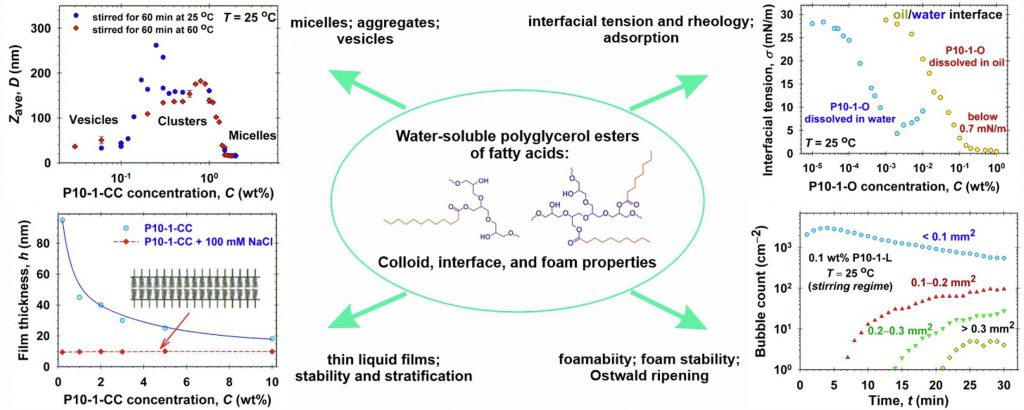
Mihail T. Georgiev, Ph.D.
Interests
- Hydrocolloids
- Complex fluids
- Surface and Interface
Publications
Most recent publications
Conformational and rheological behavior of kappa carrageenan in glycerol: Effects of sodium salts and preparation temperature
Kappa carrageenan (KC), a sulfated polysaccharide derived from red seaweed, exhibits distinct gelation properties that are influenced by ionic strength and thermal conditions. While its behavior in aqueous media is well-established, understanding KC’s gelation mechanisms in non-aqueous solvents (like glycerol) remains limited. This study investigates the conformational and rheological properties of kappa carrageenan in glycerol, focusing on the effects of sodium salts (NaCl, NaH2PO4, Na3PO4) at varying concentrations and preparation temperatures (60 °C and 80 °C). Rheological measurements reveal distinct viscosity trends influenced by salt type and temperature, highlighting the interplay between ionic interactions and KC’s conformational transitions. Phosphate salts significantly enhance network elasticity and stability, especially at intermediate concentrations, whereas NaCl induces weaker, viscosity-dominated structures. Atomic force microscopy imaging provides complementary nanoscale insights, showcasing salt-specific structural transitions from looped to branched networks, alongside a temperature-dependent helix-to-coil transformation. These results illustrate how the precisely tuning ionic conditions and the preparation temperatures in glycerol media can effectively modulate KC’s structure and viscoelastic properties. This deeper understanding facilitates targeted design and optimization of carrageenan-based materials across food, pharmaceutical, cosmetic, and biotechnological applications.

Optimizing lubricant deposition on hair-like substrates using cationic polymer/anionic surfactant complexes
Oppositely charged polymer–surfactant mixtures exhibit unique bulk and interfacial properties with many applications. In particular, cationic polymers paired with anionic surfactants are often used to deposit oils and lubricants on hair and skin upon dilution. These dilution-deposition systems are widely studied in simple mixtures but rarely in complex formulations. Thus, our paper focuses on cationic polysaccharides (cat-Guars and cat-HECs) paired with the anionic surfactant SLES-1EO (sodium laureth-1 sulfate) and incorporated into shampoos. We analyzed the polymer–surfactant complexes’ (PSCs) phase behavior, adsorption at the silicone oil/water interface, stickiness to bubbles (and drops), and deposition on hair-like substrates via phase behavior analysis, zeta potential measurements, foam film experiments, and imaging ellipsometry. Our results showed that the cat-Guar/SLES-1EO complexes exhibit wider precipitation regions and higher adsorption at the silicone oil/water interface than the cat-HEC/SLES-1EO complexes. Foam film experiments implied that only the cat-Guar/SLES-1EO complexes bridge the air bubbles (and silicone drops to hair) as they form sticky PSCs. Imaging ellipsometry revealed that cat-Guars deposit thick, inhomogeneous layers of PSCs and silicone on the hair-like substrates, whereas cat-HECs deposit thinner layers or nothing. Together, these findings elucidate the underlying deposition mechanism and offer strategies to optimize the polymer performance in shampoo formulations via a comprehensive experimental protocol.

Colloid, interface, and foam properties of water-soluble polyglycerol esters solutions
Hypothesis
Polyglycerol esters of fatty acids are generated via the esterification of a polydisperse mixture of polyglycerol with naturally derived fatty acids. The polymerization process of polyglycerol results in the production of various oligomers, ranging from di-, tri-, and higher-order forms, which contribute to the complexity of final products. The combination of complementary experimental techniques and adequate theoretical interpretations can reveal the wide variety of their physicochemical properties.
Experiments
The colloid and interface properties of polyglyceryl mono-laurate, mono-stearate, mono-oleate, and a mixture of mono-caprylate and mono-caprate esters solutions were characterized by measurements of the electrolytic conductivity, static and dynamic surface tension, aggregate and micelle sizes and distributions, thin liquid film stability and stratification, and solubility in aqueous and in oil phases. The formation, stability, and bubble size distribution of foams generated from polyglycerol esters aqueous solutions were systematically investigated.
Findings
The low concentrations of double-tail molecules and fatty acids in polyglycerol esters affect considerably their micellar, aggregation, and vesicle formations in aqueous solutions. The theoretical data interpretation of polyglycerol esters isotherms and thin liquid films data provide information on the adsorption energies, excluded areas per molecule, interaction parameters of molecules at interfaces, surface electrostatic potential, and the size of micelles. Polyglyceryl mono-oleate exhibits spontaneous emulsification properties. Short chain length polyglycerol esters have excellent foaming ability but relatively low foam stability. The optimal weight fractions of the short-chain polyglyceryl esters and polyglyceryl mono-stearate mixtures with respect to good foaminess and foam stability upon Ostwald ripening are obtained. The reported physicochemical characterization of the water-soluble polyglycerol esters could be of interest to increase the range of their applicability in practice.

Growth of giant micellar aggregates: Quantitative theory vs experiments
The concentrated surfactant solutions have a wide application in industry, oil recovery, drug delivery, turbulent drag reduction, etc. The competition between the companies-producers has led to use of new kind of formulations to improve: washing action; skin and eye irritation; stability and durability; biodegradability; tolerance to hard water. Here, we present a review on the state of the art and our contributions to the molecular thermodynamic theory and experiment on the growth of giant micellar aggregates. Despite the considerable advances in theory and computer simulations, agreement with experimental data has been achieved only in isolated cases. Our predictive molecular thermodynamic approach accounts for the different contributions to the micellar scission energy in the case of nonionic, zwitterionic and ionic surfactant solutions and their mixtures. Excellent agreement was achieved between the theoretical model and experimental data for wormlike surfactant micelles at various concentrations of salt and temperatures. At high salt concentrations, the model also predicts loss of chemical equilibrium, which implies a transition to self-assemblies of other morphology or the onset of crystallization and phase separation. The results have applications for the design of new products and nanostructured materials.
Investigation of cationic surfactants adsorption behaviour on silicon wafers using imaging ellipsometry
The research paper explores the adsorption properties of cationic surfactants on silicon wafers through imaging ellipsometry. The objective of this research is to shed light on the layer structures formed by cationic surfactants, specifically those based on dimethyl ammonium chloride, on silicon wafers. The study involved the deposition of three distinct cationic surfactants on the wafer’s surface, followed by the measurement of the adsorption layers formed. The findings reveal the creation of thin, smooth, and irregular adsorption layers. Interestingly, no correlation was found between the thickness of the adsorption layer and the surfactant tail’s chain length. The research underlines the significant role which the imaging ellipsometry can have for studying surfactants’ adsorption properties on surfaces, contributing to their optimal usage in various fields.

